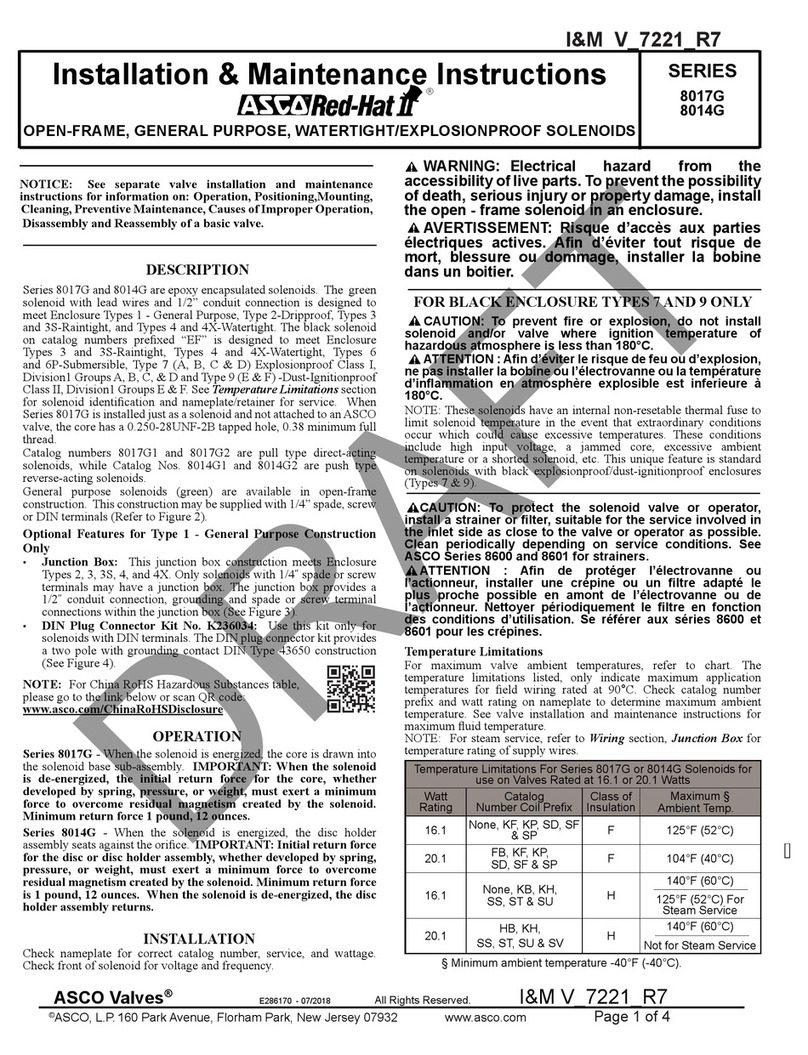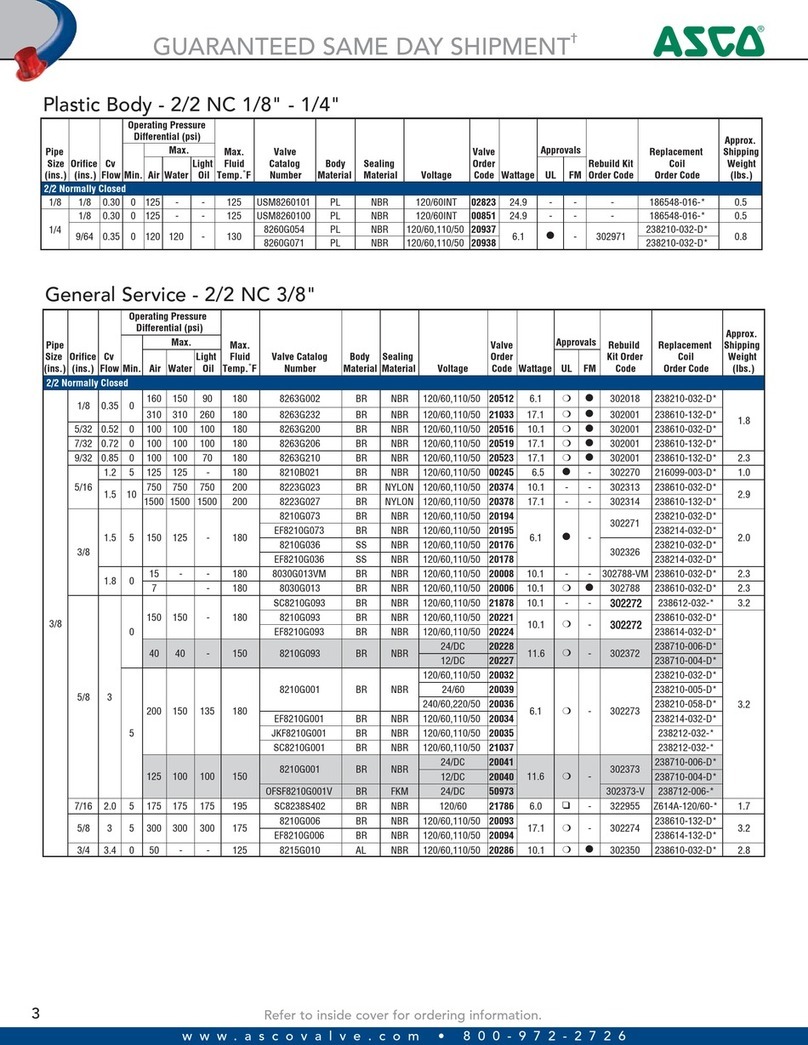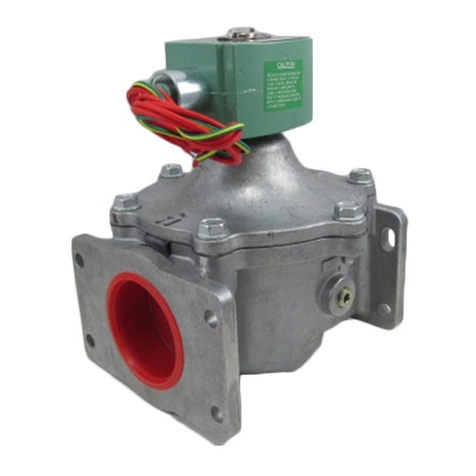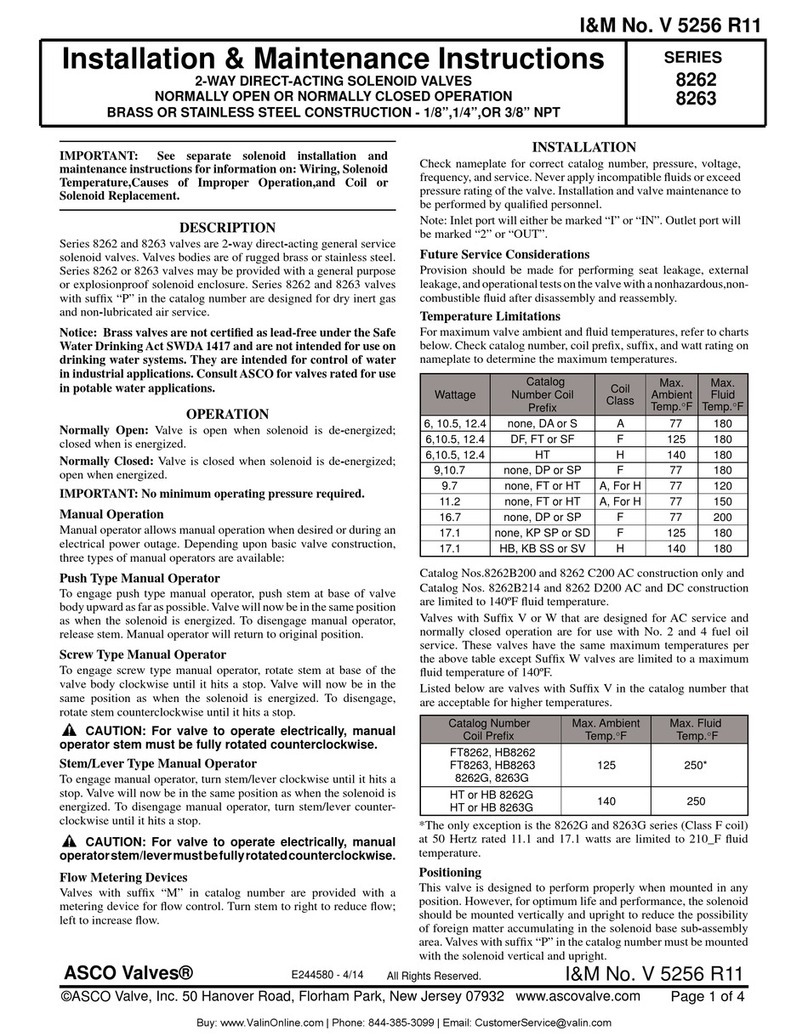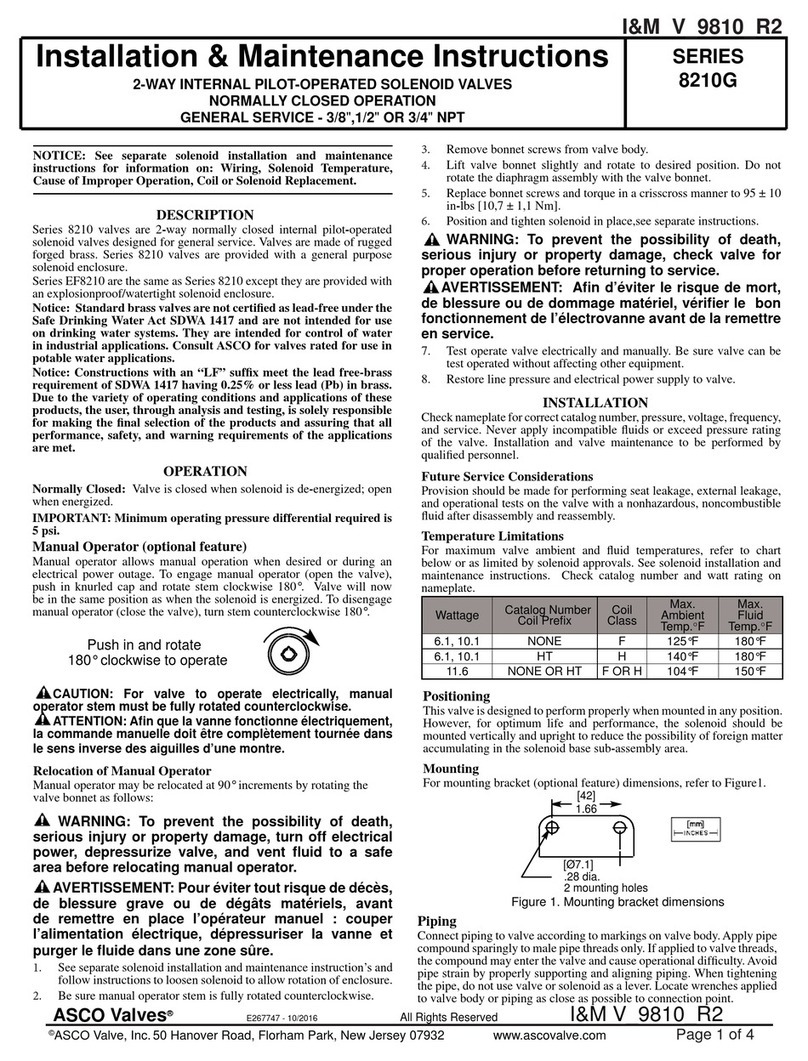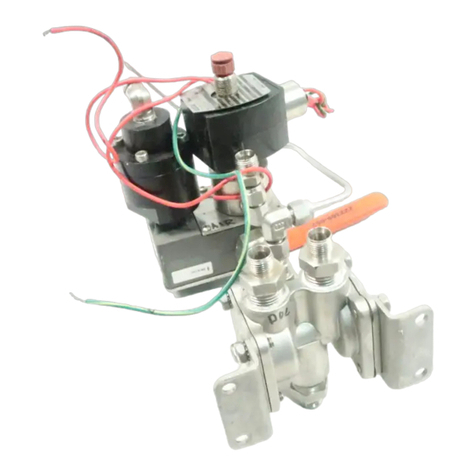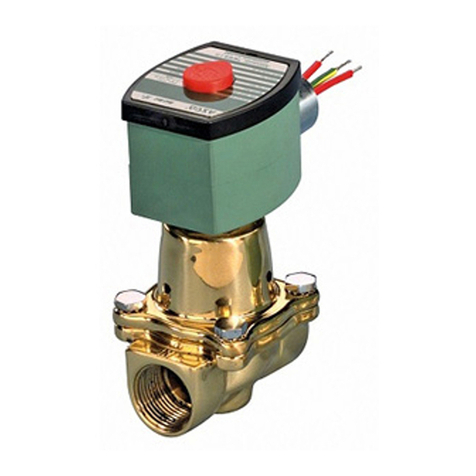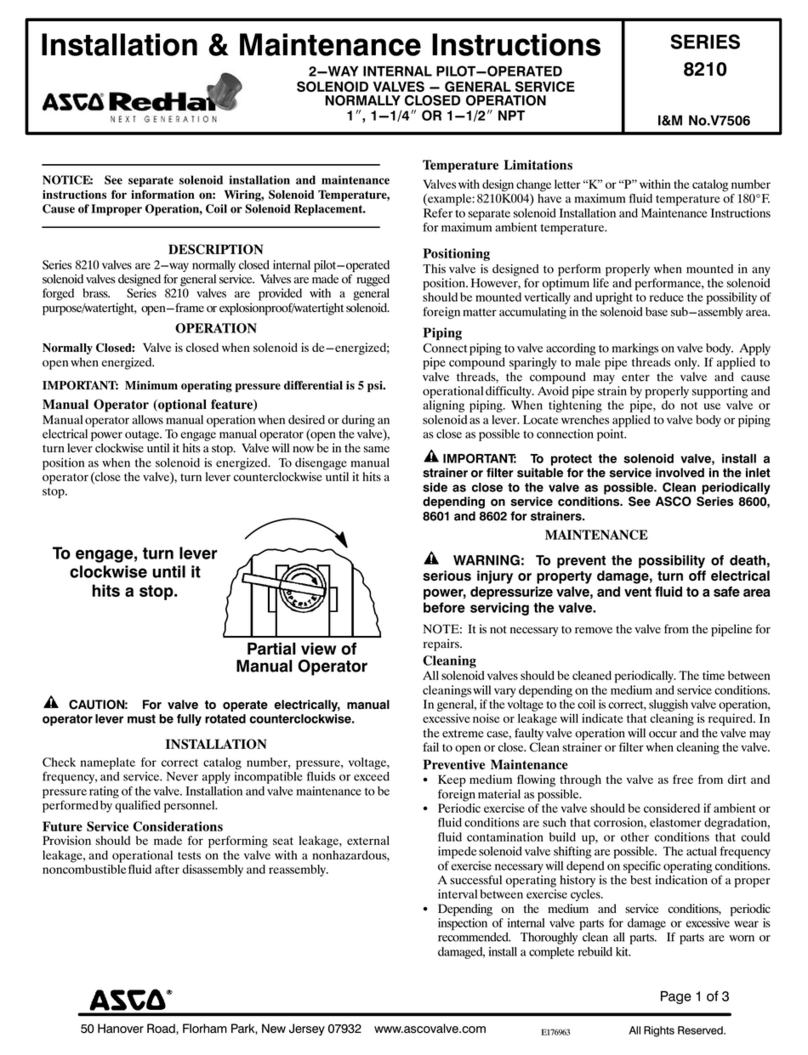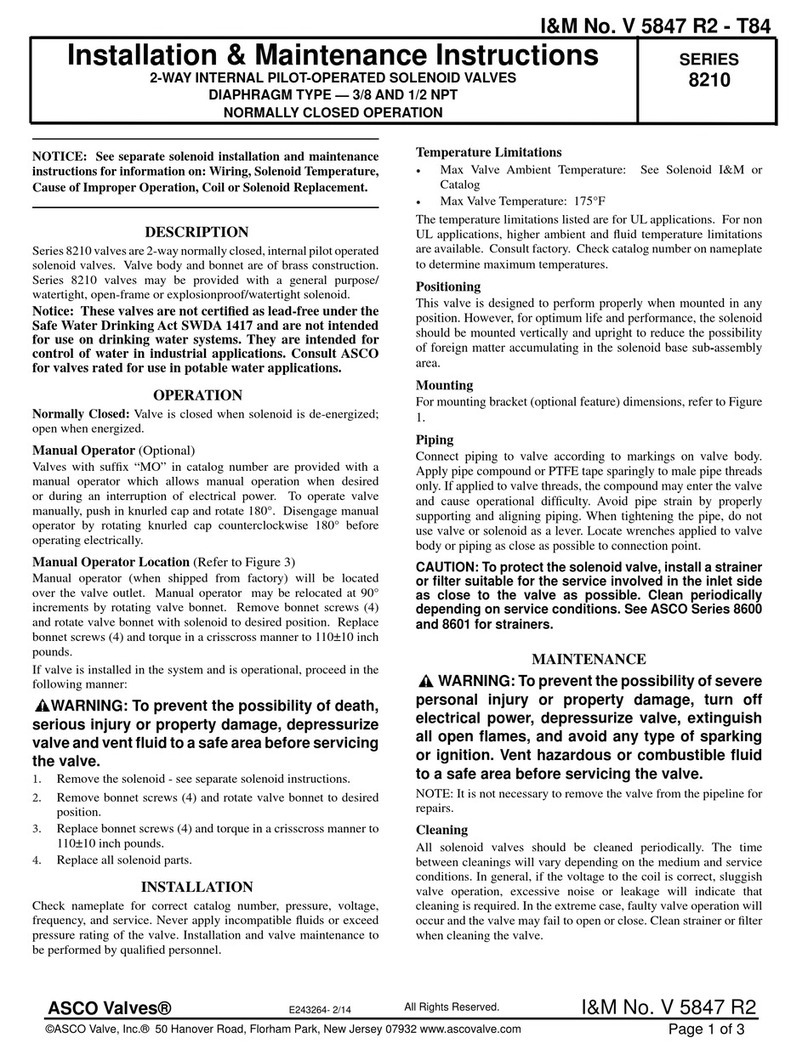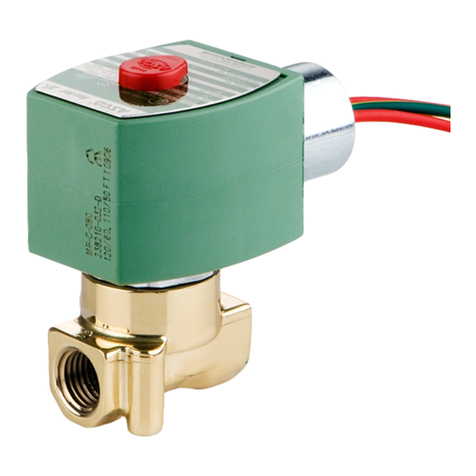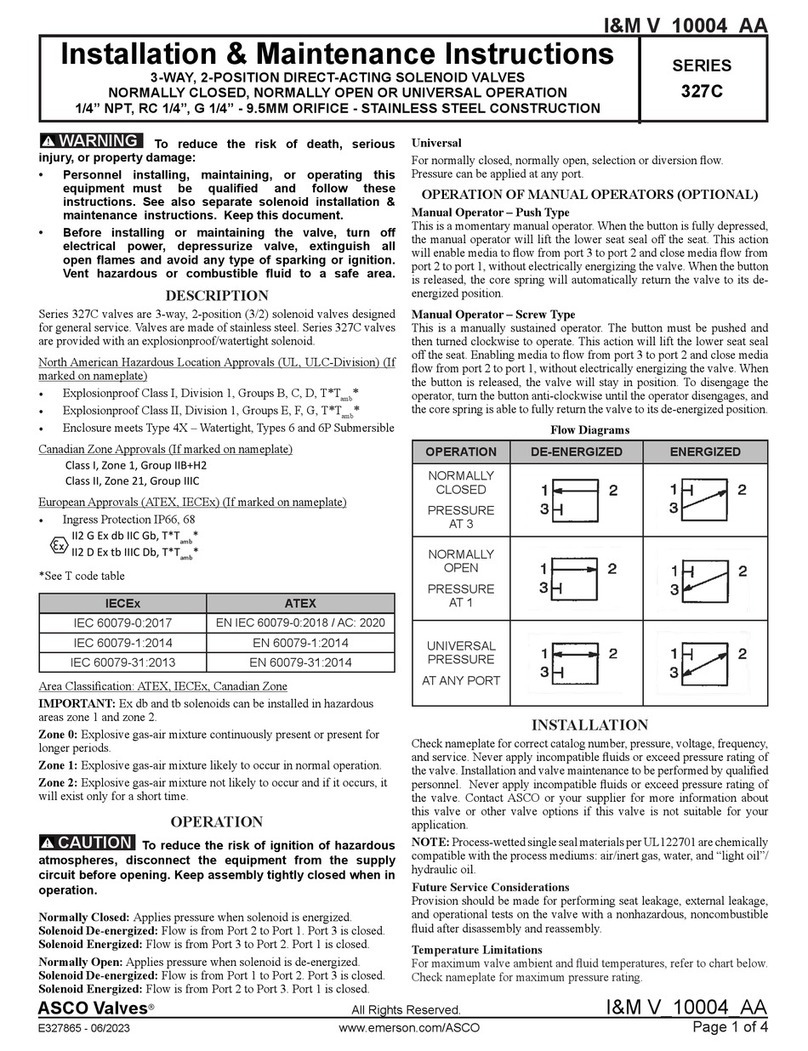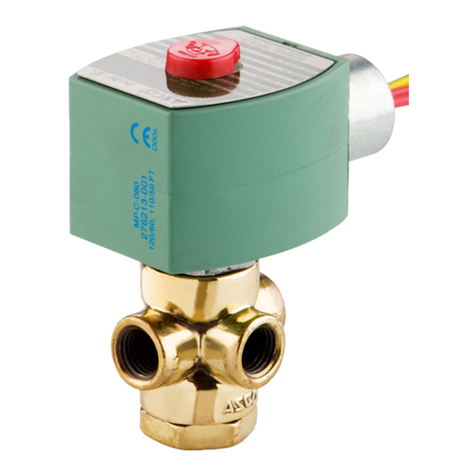
Page 2 of 4 I&M No. V_5436_R13
©ASCO Valve, Inc. 50 Hanover Road, Florham Park, New Jersey 07932 www.ascovalve.com
Cleaning
All solenoid valves should be cleaned periodically. The time between
cleanings will vary depending on the medium and service conditions.
In general,if the voltage to the coil is correct, sluggish valve operation,
excessive noise or leakage will indicate that cleaning is required. In the
extreme case, faulty valve operation will occur and the valve may fail to
open or close. Clean strainer or lter when cleaning the valve.
Preventive Maintenance
• Keep medium owing through the valve as free from dirt and foreign
material as possible.
• Periodic exercise of the valve should be considered if ambient or
uid conditions are such that corrosion, elastomer degradation,
uid contamination build up, or other conditions that could impede
solenoid valve shifting are possible. The actual frequency of exercise
necessary will depend on specic operating conditions. A successful
operating history is the best indication of a proper interval between
exercise cycles.
• Depending on the medium and service conditions, periodic inspection
of internal valve parts for damage or excessive wear is recommended.
Thoroughly clean all parts. If parts are worn or damaged, install a
complete rebuild kit.
Causes of Improper Operation
• Incorrect Pressure: Check valve pressure. Pressure to valve must
be within range specied on nameplate.
• Excessive Leakage: Disassemble valve and clean all parts. If parts
are worn or damaged, install a complete ASCO Rebuild Kit.
Valve Disassembly
1. Disassemble valve in an orderly fashion using exploded views for
identication and placement of parts. Refer to Figure 1 for AC
construction; Figure 2 for DC construction. For 1" or 1 ¼" NPT
valve construction, see Figure 1; for 1 ½" NPT valve construction,
see Figure 2.
2. Remove solenoid enclosure. See separate instructions.
• For valves supplied with optional manual operators,see section on
Disassembly of Manual Operator.
3. Unscrew solenoid base sub-assembly from valve body. Then
remove core assembly with core spring and solenoid base gasket.
For AC construction (Figure 1) core spring is a loose piece.
4. For normal maintenance (cleaning) it is not necessary to remove
the valve seat. However, for valve seat removal use a 7/16" thin
wall socket wrench
5. Remove bonnet screws, valve bonnet, diaphragm spring,
diaphragm assembly, body gasket, body passage eyelet(present on
current valve constructions only) and body passage gasket.
6. All parts are now accessible for cleaning or replacement. If parts
are worn or damaged, install a complete ASCO Rebuild Kit.
- Service Notice -
When installing a new ASCO Rebuild Kit, please be aware that the
diaphragm assembly may not be identical to the diaphragm assembly
in the valve. See Figure 1 for alternate diaphragm constructions. The
two diaphragm constructions are interchangeable and will perform
equally well.
CAUTION: To ensure proper valve operation, install all
parts supplied in ASCO Rebuild Kit. Do not mix old and new
parts.
ATTENTION: Pour assurer un fonctionnement correct de
la vanne, installer toutes les pièces fournies dans le kit de
réfection ASCO. Ne mélangez pas les anciennes pièces avec
les neuves.
Valve Reassembly
1. Lubricate body gasket, body passage gasket, bonnet gasket and
solenoid base gasket with Xiameter® PMX 200 Silicone Fluid or
an equivalent high-grade silicone uid.
2. Install body passage gasket, body passage eyelet, diaphragm
assembly, diaphragm spring, valve bonnet and bonnet screws.
Hand thread screws as far as possible. Then torque bonnet screws
in a crisscross manner to 144 ± 15 in-lbs [16,3 ± 1,7 Nm].
3. If removed, install valve seat in valve body. Apply a small amount
of thread compound compatible with valve media to valve seat
threads. Torque valve seat to 75 ± 10 in-lbs [8,5 ± 1,1 Nm].
• For valves supplied with optional manual operator, see section on
Reassembly of Manual Operator.
4. For AC construction (Figure 1), install core spring in core
assembly. Wide end of core spring in core rst, closed end
protrudes from top of core.
5. Install solenoid base gasket, core assembly with core spring and
solenoid base sub-assembly in valve body. Torque solenoid base
sub-assembly to 175 ± 25 in-lbs [19,8 ± 2,8 Nm].
6. Install solenoid. See separate instructions.
WARNING: To prevent the possibility of death,
serious injury or property damage, check valve for
proper operation before returning to service. Also
perform internal seat and external leakage tests with a
nonhazardous, noncombustible uid.
AVERTISSEMENT: An d’éviter le risque de mort,
de blessure ou de dommage matériel, vérier le bon
fonctionnement de l’électrovanne avant de la remettre
en service. Contrôler aussi les fuites externe et interne
avec un uide non dangereux.
7. Restore line pressure and electrical power supply to valve.
8. After maintenance is completed, operate the valve a few times
to be sure of proper operation. A metallic click indicates the
solenoid is operating.
Disassembly of Manual Operator
1. Unscrew solenoid base sub-assembly from manual operator body.
2. Unscrew manual operator body from valve body. Then remove
stem retainer from base of manual operator body and stem/spacer
sub-assembly.
3. Pull stem/spacer sub-assembly with stem gasket from side of
manual operator body. Then remove core assembly with core
spring, solenoid base gasket and manual operator bonnet gasket.
4. For further disassembly refer to section on Valve Disassembly
step 4.
Reassembly of Manual Operator
1. Lubricate stem gasket with Molykote® 111 Compound or
equivalent high-grade silicone grease.
2. For AC construction (Figure 1), install core spring in core
assembly. Wide end of core spring in core rst, closed end
protrudes from top of core.
3. Holding the manual operator body in a horizontal position, install
core assembly with core spring from the bottom end.
4. Insert the stem/spacer sub-assembly with the stem gasket into the
side hole of the manual operator body. Rotate the lever of the
stem/spacer sub-assembly to the 12 o’clock position.
5. Install stem retainer on base of manual operator body and
simultaneously engage it into the slot provided on the stem/
spacer sub-assembly.
IMPORTANT: The spacer on the stem/spacer sub-assembly must
be inside of the stem retainer for AC construction (Figure 1) and
outside of the stem retainer for DC construction (Figure 2).
6. Install manual operator bonnet gasket and body with preassembled
parts into valve body. Torque manual operator body to 175 ± 25
in-lbs [19,8 ± 2,8 Nm].
7. Replace solenoid base gasket and solenoid base sub-assembly.
Torque solenoid base sub-assembly to 175 ± 25 in-lbs [19,8 ±
2,8 Nm].
8. For further reassembly, refer to Valve Reassembly step 6.
ORDERING INFORMATION
FOR ASCO REBUILD KITS
Parts marked with an asterisk (*) in the exploded view are supplied in
Rebuild Kits. When Ordering Rebuild Kits for ASCO valves, order the
Rebuild Kit number stamped on the valve nameplate. If the number of
the kit is not visible, order by indicating the number of kits required, and
the Catalog Number and Serial Number of the valve(s) for which they
are intended.
